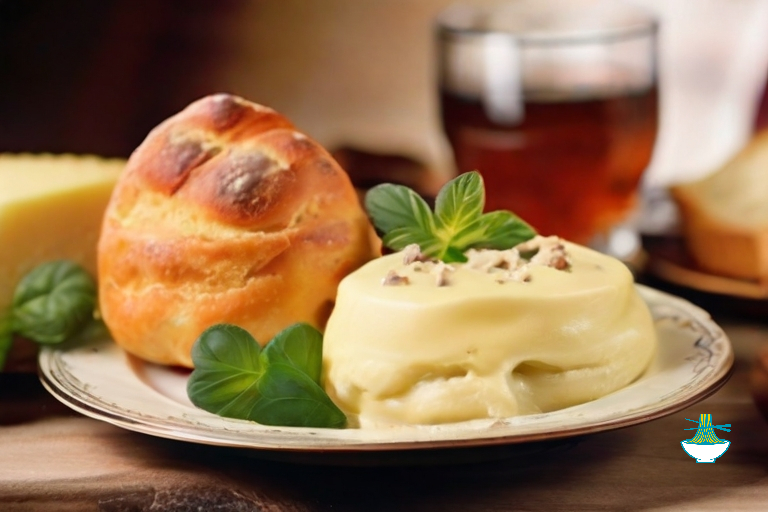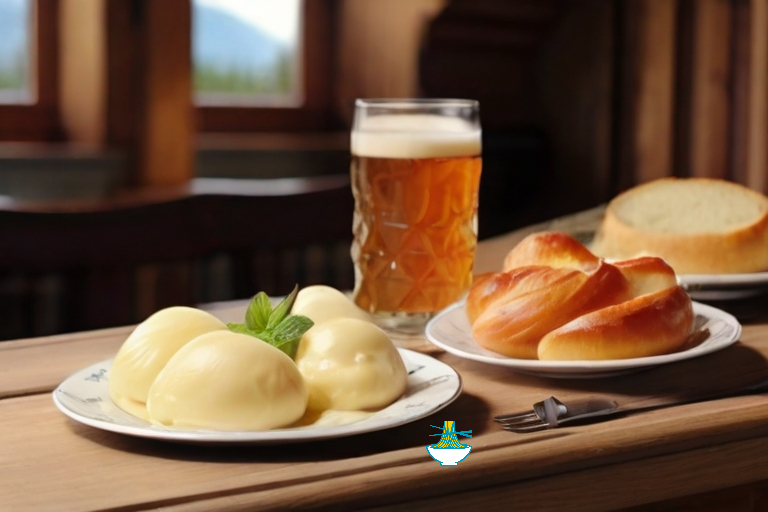Buchteln are sweet, fluffy Austrian buns, traditionally filled with jam or sweetened quark cheese. This popular treat is enjoyed in Austria, Germany, and across Central Europe. Known for their soft, slightly sweet dough and delightful filling, Buchteln offer a burst of fruity or creamy flavor, making them perfect for breakfast, brunch, or dessert.
In addition to their delicious taste, Buchteln provide essential nutrients. They are a source of carbohydrates, giving the body energy, and contain small amounts of protein, which is essential for muscle repair and growth. The quark cheese filling offers a good source of calcium, important for bone health, while the jam provides vitamins from the fruit, such as Vitamin C, which supports the immune system. However, like many sweet treats, Buchteln are high in sugar, which can contribute to weight gain and an increased risk of diabetes if consumed excessively.
While Buchteln are a comforting indulgence, it's best to enjoy them in moderation to benefit from their nutritional value while avoiding the potential downsides of overconsumption.

To make Buchteln, you will need the following
ingredients:
1- 4 cups all-purpose flour
2- 1 cup lukewarm milk
3- 1/2 cup granulated sugar
4- 1/4 cup unsalted butter, melted
5- 2 large eggs
6- 1 package active dry yeast
7- 1/2 teaspoon salt
8- 1/2 teaspoon vanilla extract
9- 1/2 teaspoon lemon zest
10- 1/2 cup jam or sweetened quark cheese (for filling)
11- Powdered sugar (for dusting)
Here's the step-by-step method for making Buchteln:
1- In a large mixing bowl, combine the lukewarm milk, sugar, and yeast. Stir well and let it sit for 5-10 minutes until the yeast is activated and the mixture becomes frothy.
2- Add the melted butter, eggs, salt, vanilla extract, and lemon zest to the bowl. Mix well.
3- Gradually add the flour to the bowl and mix until a soft, sticky dough forms.
4- Knead the dough on a floured surface for 5-10 minutes until it becomes smooth and elastic.
5- Place the dough back in the bowl, cover it with a clean cloth, and let it rise in a warm place for 1 hour or until it has doubled in size.
6- Preheat the oven to 350°F (180°C).
7- Roll out the dough on a floured surface to a thickness of about 1/4 inch.
8- Use a round cookie cutter or drinking glass to cut out circles of dough.
9- Place a teaspoon of jam or sweetened quark cheese in the center of each dough circle.
10- Carefully pull the edges of the dough up and around the filling, pinching them together to form a sealed ball.
11- Place the filled dough balls in a greased baking dish, leaving a little space between them.
12- Cover the dish with a clean cloth and let the Buchteln rise again for 15-20 minutes.
13- Bake the Buchteln in the preheated oven for 25-30 minutes, or until they are golden brown and fully cooked.
14- Remove the Buchteln from the oven and let them cool for a few minutes.
15- Dust the Buchteln with powdered sugar and serve warm.
Additional Tips for Serving
- As a Breakfast or Brunch Dish: Serve warm with a cup of coffee, tea, or fresh juice. The sweet and comforting nature of Buchteln pairs perfectly with a warm beverage.
- As a Dessert: Dust them with powdered sugar and pair them with a dollop of whipped cream or a scoop of ice cream for a decadent dessert.
- Unique Pairings: For a twist, serve Buchteln with fruit salads or fresh berries to complement their sweetness and add a refreshing contrast. You can also pair them with hot chocolate or a rich coffee for an indulgent treat.
Notes:
1- Buchteln can be made with a variety of fillings, including Nutella, fruit preserves, and sweetened cream cheese.
2- To make sweetened quark cheese, mix together 1 cup of quark cheese, 1/4 cup granulated sugar, and 1 egg yolk until smooth.
3- Buchteln are best served warm and fresh from the oven, but they can be stored in an airtight container for up to 2 days.
Frequently Asked Questions
1.What are the best fillings for Buchteln?
- The traditional fillings for Buchteln are jam or sweetened quark cheese, but there are many other options. Nutella, caramel, or fresh fruit (such as berries) can create a unique twist on the classic recipe. For a savory version, you could also use cheese or ham.
2.Can Buchteln be made without yeast?
- Yes, it's possible to make Buchteln without yeast, though they won’t have the same fluffy texture. Instead, you can use baking powder or baking soda as a leavening agent, but the dough will be denser. This can be a good option for those who don’t have yeast or prefer a quicker recipe.
3.Can Buchteln be stored?
- Yes, Buchteln can be stored in an airtight container for up to two days at room temperature. For longer storage, place them in the refrigerator, where they can last for up to a week. You can also freeze them for up to 3 months. To reheat, simply warm them in the oven for a few minutes.
4.What are the exact nutritional values of Buchteln?
- The nutritional values of Buchteln depend on the specific ingredients used, but a standard serving provides approximately 238 calories, with 42g of carbohydrates, 16g of sugar, 5g of protein, and 5g of fat. The values can be adjusted by using whole wheat flour, reducing sugar, or switching to a lower-fat filling.
5.Are there healthy alternatives to Buchteln?
- Yes, there are healthier versions of Buchteln. You can substitute all-purpose flour with whole wheat flour for added fiber. Additionally, using less sugar or a sugar alternative, and choosing lower-fat fillings like plain yogurt instead of quark cheese, can make the recipe lighter. If you're concerned about calories, try using fruit preserves without added sugar for a healthier filling option.
Health Benefits
- Flour: All-purpose flour is the main ingredient in Buchteln, providing carbohydrates that are the body's primary source of energy. However, it can be swapped with whole wheat flour for additional fiber, which aids digestion and can help manage blood sugar levels.
- Milk: Milk is a key ingredient, rich in calcium, which is essential for bone health. It also provides vitamin D, helping the body absorb calcium more efficiently. Milk is a good source of protein, which helps in muscle repair and growth, making it an excellent addition to any diet.
- Quark Cheese: The traditional filling of quark cheese is a source of calcium and protein, both of which are vital for maintaining strong bones and muscle function. It also contains probiotics, which support gut health and improve digestion.
- Jam: While jam is high in sugar, it also contains vitamins, particularly vitamin C when made from fruits like berries. Vitamin C is crucial for the immune system, and it promotes healthy skin and tissue repair. To reduce sugar intake, you can opt for homemade or no-sugar-added jams.
Nutrition Facts (per serving):
- Calories: 238
- Fat: 5g
- Saturated Fat: 3g
- Cholesterol: 44mg
- Sodium: 140mg
- Carbohydrates: 42g
- Fiber: 1g
- Sugar: 16g
- Protein: 5g
4 cups all-purpose flour:
- Calories: ~480 kcal
- Carbohydrates: ~96g
- Protein: ~12g
- Fat: ~1g
- Sodium: ~8mg
1 cup lukewarm milk:
- Calories: ~80 kcal
- Carbohydrates: ~12g
- Protein: ~6g
- Fat: ~2g
- Sodium: ~100mg

1/2 cup granulated sugar:
- Calories: ~387 kcal
- Carbohydrates: ~100g
- Protein: ~0g
- Fat: ~0g
- Sodium: ~1mg
1/4 cup unsalted butter, melted:
- Calories: ~407 kcal
- Carbohydrates: ~0g
- Protein: ~0.4g
- Fat: ~45g
- Sodium: ~2mg
2 large eggs:
- Calories: ~140 kcal
- Carbohydrates: ~1.2g
- Protein: ~12g
- Fat: ~10g
- Sodium: ~140mg
1 package active dry yeast:
- Calories: ~8 kcal
- Carbohydrates: ~1.6g
- Protein: ~1.2g
- Fat: ~0.1g
- Sodium: ~0mg
1/2 teaspoon salt:
No significant nutritional content
- Sodium: ~1160mg
1/2 teaspoon vanilla extract:
- Calories: ~6 kcal
- Carbohydrates: ~0.3g
- Protein: ~0g
- Fat: ~0g
- Sodium: ~0mg
1/2 teaspoon lemon zest:
- Calories: ~0 kcal
- Carbohydrates: ~0g
- Protein: ~0g
- Fat: ~0g
- Sodium: ~0mg
1/2 cup jam or sweetened quark cheese (for filling):
- Nutritional values vary greatly based on the specific jam or cheese used. Please refer to the product packaging for accurate information.
Powdered sugar (for dusting):
- Calories: ~32 kcal
- Carbohydrates: ~8g
- Protein: ~0g
- Fat: ~0g
- Sodium: ~0mg
Please keep in mind that these values are rough estimates and should not be used for strict dietary purposes. The actual nutritional content of your final dish will depend on the specific brands and quantities you use.


Comments